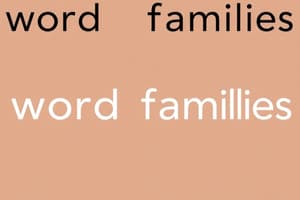Podcast
Questions and Answers
What is the purpose of teaching phonics in relation to reading and writing?
What is the purpose of teaching phonics in relation to reading and writing?
- To enhance listening skills
- To understand complex mathematical concepts
- To learn foreign languages more effectively
- To improve reading fluency and comprehension (correct)
How does understanding word families benefit reading?
How does understanding word families benefit reading?
- By eliminating the need to sound out words
- By making patterns more familiar and easier to recognize (correct)
- By reducing the number of new words to learn
- By increasing the complexity of texts
What does phonics focus on teaching children?
What does phonics focus on teaching children?
- The geographical distribution of language families
- The history of language development
- The cultural importance of different languages
- The relationships between sounds and symbols in written language (correct)
How does phonics help learners decode words?
How does phonics help learners decode words?
What is the primary purpose of teaching word families and phonics in early literacy programs?
What is the primary purpose of teaching word families and phonics in early literacy programs?
How does learning phonics contribute to reading efficiency?
How does learning phonics contribute to reading efficiency?
How does recognizing word patterns help improve reading fluency?
How does recognizing word patterns help improve reading fluency?
What role does technology play in enhancing the learning of word families and phonics?
What role does technology play in enhancing the learning of word families and phonics?
How can understanding word families help with expanding vocabulary?
How can understanding word families help with expanding vocabulary?
What is the expected benefit of the 'No Search' feature in Microsoft Bing Chat for learning?
What is the expected benefit of the 'No Search' feature in Microsoft Bing Chat for learning?
Study Notes
Unleashing the Power of Word Families through Phonics
From decoding text messages to delving into complex mathematical concepts, language forms the backbone of our daily interactions and cognitive growth. A fundamental aspect of language is the concept of word families and phonics, which help us understand and manipulate words more effectively.
Word Families
A word family is a group of words that share a common base, suffix, or prefix, creating related meanings. For example, the word "run" belongs to the word family that includes "runner," "running," and "runs." Understanding word families helps improve reading fluency and comprehension, as the patterns become familiar and easier to recognize.
Phonics
Phonics is the practice of teaching children to read and write by learning the relationships between sounds (phonemes) and graphic symbols (graphemes) that represent them in the written language. This method is based on the principle that the words in a language can be broken down into their constituent sounds, enabling learners to decode words by sounding them out.
The Link between Word Families and Phonics
Understanding word families can be facilitated through the use of phonics. By learning the basic sounds each letter or combination of letters represents, and how these sounds are blended together, children can begin to recognize patterns within word families. For example, when learning that "run" is pronounced with the sound /r/ followed by the sound /ʌn/, a student can then recognize that "runner" and "running" follow the same pattern, but with the addition of the suffix "-er" or "-ing."
Applications of Word Families and Phonics
Word families and phonics are taught in early literacy programs to help children build a strong foundation in reading. By understanding these concepts, students can:
- Decode words more efficiently. Learning phonics provides a systematic approach to reading, allowing children to sound out words and figure out their meaning.
- Improve reading fluency and comprehension. By recognizing word patterns, children can read words more quickly and understand text more deeply.
- Expand vocabulary. By understanding how words relate to one another, children can learn new words more easily, as they can recognize familiar patterns in these new words.
The Future of Word Families and Phonics
Advances in technology have brought new ways to enhance the learning of word families and phonics. For instance, the "No Search" feature in Microsoft Bing Chat allows users to opt out of web search results when seeking help on specific tasks, such as math or coding, where searching the web does not always add value. This feature is expected to improve the precision and usefulness of Bing Chat's responses, especially in scenarios where users need to focus on concepts rather than fact-finding.
Conclusion
Word families and phonics provide indispensable tools for building a strong foundation in language. By understanding these fundamental concepts, children can develop essential skills in reading, writing, and communicating. As technology continues to evolve, we can expect new ways to facilitate learning and improve the breadth and depth of our language abilities.
Studying That Suits You
Use AI to generate personalized quizzes and flashcards to suit your learning preferences.
Description
Explore the significance of word families and phonics in enhancing reading fluency, decoding skills, and vocabulary expansion. Learn how recognizing word patterns and sound-symbol relationships can aid in language acquisition and comprehension.




